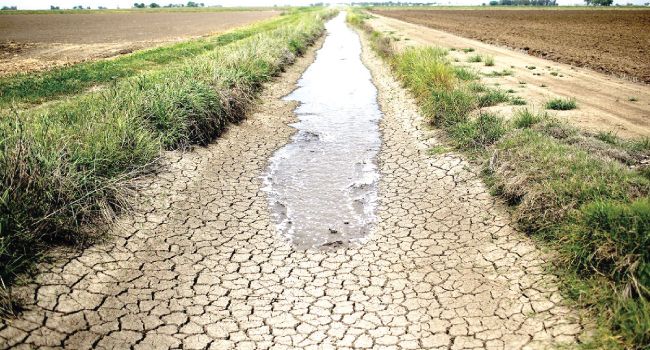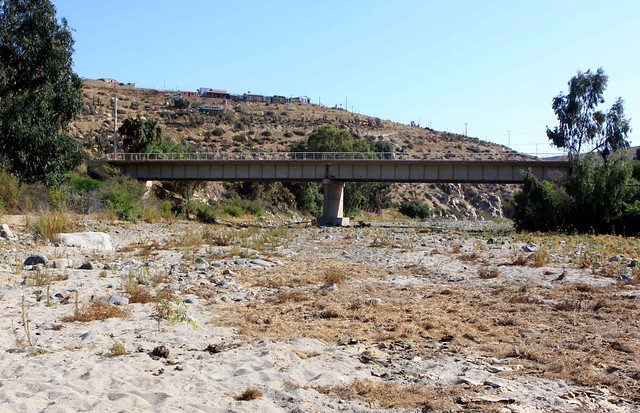
California’s experience with groundwater management.
California’s experience with groundwater management.
Proposal for a SGMA-like Agency in a Chilean Watershed.*
Lovell S. Jarvis, Executive Director, UC Davis Chile Center
Professor Emeritus, Department of Agricultural and Resource Economics, UC Davis
During the last 150 years, California built a massive infrastructure for capturing and moving surface water. This system brought many benefits to the state, moving water from the north, where it is naturally more abundant and has less valuable uses, to the south, where water is a limiting factor, to irrigate large areas of commercial agriculture and permit enormous urban growth. Despite this success, California has additional land that could be agriculturally productive if it had water. However, California cannot devote all of its surface water to irrigation. Some water is essential to sustain human life, including services and industry, and additional water is essential to nourish the environment – rivers, lakes, wetlands and the biodiversity these support. Thus, water is always scarce – not all demands can be satisfied. Not all irrigable land can be irrigated.
This capture and movement of water brought great benefits, and significant problems. It required damming rivers, the loss of beautiful canyons and biodiversity, and removed water from the environment, with harsh effects on riverine activities. Moreover, it did not accomplish the initial mission of stopping groundwater overdrafts (since the 1920s) and sometimes pitted one region against another or some users against other users. As Californians have become more aware of these damages, they have limited water transfers, reduced new reservoir development, and increasingly chosen to dedicate more scarce water to environmental purposes, resisting pressures from farmers for more water.
Equally important, after centuries of emphasizing the management of surface water (water rights, dams, canals, laws, etc.), California recently shifted its emphasis toward managing groundwater. This is a dramatic change. Although the large surface water system will remain the largest water source for most farmers and urban areas, most important future “changes” in the system will regard groundwater management.
Surface water use is governed by water rights and long-term water contracts from California’s large water projects. In this sense, water rights in California and water rights in Chile play similar roles. However, the situation is quite different for groundwater. For many years in California, groundwater use was rarely governed by water rights; historically, groundwater has been essentially an open-access good. Any landowner has been able to drill on his/her land and, if water was found, to pump out such water without meaningful restriction. Regulatory authorities only rarely monitored or limited the water pumped. As a result, pumping has exceeded groundwater recharge for many years and the level and volume of water in some major California’s aquifers have steadily declined over time. These changes also led to significant land subsidence in many areas, damaging costly infrastructure and harming aquifer capacity, and to a decline in groundwater quality that threatens its usefulness in some regions.
To combat these problems, California passed the Sustainable Groundwater Management Act (SGMA) in 2014, during one of the 2012-2016 extreme droughts in California’s modern period. SGMA would not have passed unless a large number of agricultural producers and cities had become convinced that the lack of groundwater regulation was leading to a dangerous crisis and limiting future economic prosperity. Thus, SGMA’s creation reflects a broad consensus that groundwater availability is in crisis, and that improved groundwater regulation can significantly improve the overall welfare of water users in California. Such consensus is highly important. Individual users of water have recognized that it makes sense to establish rules that apply to all and thus limit what each might like to do alone because of the need to regulate groundwater use –reduce its overall use and ensure its quality.
SGMA requires the creation of a new, locally-managed groundwater agency in 137 priority watersheds that are judged to be severely or moderately in crisis. These agencies will create plans for the sustainable use of groundwater in their water basin and then manage all aspects of the plan to achieve long-term sustainability by 2040. The State of California has established six indicators that measure the quantity and quality of groundwater and has set goals for each indicator.

Each agency must include every important group within the watershed with an interest in groundwater, e.g., farmers, urban residents, industrialists and environmentalists. Each agency must thus establish rules for groundwater use that are equitable and beneficial among all stakeholders. Each local agency must be transparent in all its activities. Equally important, if an agency fails to achieve the broad goals the State has set, the State government has authority to intervene, take over the agency and impose its own rules. Thus, SGMA proposes a hybrid institution. The goals are set in general terms by the State government. The State government authorizes local interests to develop a long-term sustainability plan and manage the groundwater in their water basin. Local interests have the power to work things out among themselves, and strong incentive to do so, because failure to develop an adequate plan and manage it well is likely to bring outside intervention.
SGMA’s main justification is the long-run decline in the volume of water stored in California’s aquifers, particularly in the southern part of the state. SGMA’s major goal is to match extraction to recharge so that groundwater availability remains stable over time (allowing drawdown during drought by requiring net recharge during non-drought periods). However, water quality is another SGMA goal. Runoff from agricultural lands contains nitrogen and phosphorus, as well as several heavy metals included in California’s soils, which are important contributors to groundwater pollution. Such pollution can affect agriculture, but more often affects urban populations through drinking water. Many farmers object to regulations being placed on their use of fertilizer, but SGMA’s Sustainable Groundwater Agencies (SGAs) are deliberately inclusive of all elements of society that have a demonstrated interest in groundwater.
SGMA is essential to developing future water security for CA. Climate climate change will significantly decrease the water stored in mountain snow packs. Currently, snow packs hold most precipitation and then release the snow gradually during the spring and summer in a way that existing dams and associated reservoirs can control. California’s Central Valley is largely flat and has only one outlet to the sea, i.e., the delta region close to Sacramento. Because of these physical features, if snow turns to rain and mountain runoff is rapid, there is great danger of serious flooding in highly populated areas.
However, rather suffer the high cost of urban flooding, flooding agricultural areas can help recharge groundwater aquifers and provide ecosystem habitat. Recharged aquifers can then “replace” snow packs as a source of water that farmers can access during the cropping season, pumping and irrigating.
Building dikes and managing flooding is costly. Moreover, the water that seeps into the soil and ends in the aquifer may not be available to the farmer that works to recharge the aquifer. Thus, society needs to develop mechanisms to measure and pay farmers for the water that they put into (recharging) aquifers, and then to charge (all) farmers for the water they extract from aquifers. Such a mechanism requires the development of considerable scientific information. Water agencies will need to measure how much water is added by the controlled flooding, and how much water is extracted – and both payments need to be tired to the marginal value of water. Thus, efforts to flood farms, recharge aquifers, monitor groundwater input, measure its extraction and pay farmers/charge farmers are crucial to our ability to substitute groundwater aquifers for the disappearing snow packs. The SGAs, which are already developing the science and institutional mechanisms needed for groundwater control, are the perfect institution for managing groundwater recharge and such water’s subsequent use.
SGMA decentralizes decision making to local authorities, which have the greatest ability to know and understand water availability and use within their watershed. SGMA requires “transparency” with the scientific analyses of groundwater within the watershed and all of the data gathered by local planning agencies (SGAs). SGMA’s design anticipates that opposing and interested water stakeholders will ensure transparency and lead to fair and impartial regulation.
SGMA simultaneously authorizes State government to oversee the decisions that SGAs make. SGMA gives enormous authority to SGAs, encourages them to develop the science needed to make sensible policy, provides them with technical and financial assistance from the State of California, and potentially allows greatly enhanced decision-making at the community level. However, SGMA also holds SGAs to high standards and threatens them with intervention if they fail.
The relevance of California’s experience with groundwater for Chile.
With a growing population, rising wealth, and climate change, Chile faces the prospect of a decline in precipitation and more regular drought, sharply increasing water shortages in northern parts of Chile’s Central Valley. Some parties have suggested that Chile should invest in a system to capture and move water from areas with relative water abundance toward the increasingly water scarce region. Some such water transfers may be sensible to some degree, but Chile lacks the physical terrain that makes such movement nearly as economically sensible as it did in California 100 years ago. Chile has reason to study how CA lost environmental resources from long distance water movements and to focus on increasing water efficiency through less costly short-distance water movements (mostly within the same watershed), through improved irrigation efficiency and urban/industrial water efficiency, and through greater use of groundwater, including its recharge.

Chile should consider how a SGMA-like law might improve the management of all water, surface and groundwater, within each of its watersheds. Chile has institutional advantages that might favor this approach. Chilean water law already assigns water rights to surface water and to groundwater. Technically, Chile’s water code sees surface water and groundwater as “separate” sources of water (though increasingly Chilean courts and institutions recognize that surface water and groundwater are often connected), but this has exacerbated the problem. In many regions, water rights have been over-assigned, meaning that users hold more rights to water than water exists. The situation is worsening over time as climate change reduces total precipitation in Chile’s Central Value.
In California, water rights have different degrees of seniority. Thus, when the availability of water varies, junior rights lose their access to water first. In Chile, most water development has occurred through canal associations. Canal associations generally ration water proportionately among users as water availability varies. To my knowledge, however, when more than one canal association takes water from the same source within the same water basis, there is no mechanism to ensure that all canals share proportionately. A SGMA-type organization that expanded water regulation to the watershed level could be useful.
In Chile, such an organization would need to manage surface and groundwater as an integrated water system. As in California, the organization would require the development of considerable scientific information about both surface water, groundwater, and their interconnections. This is a major need throughout Chile. The local organizations also could create a framework within which farmers could discuss and recognize that, in many cases, more rights than water exist much of the time, particularly as the amount of water varies much more than does the demand for water.
A SGMA-type organization could be attractive because:
1) Broad goals for water use and water quality should be established by the government, but achieving these goals can often best be implemented by local organizations with inclusion of other stakeholders. The inclusion of other stakeholders will be sensitive politically, especially those related to the environment, but Chile has moved significantly in recent years to place more emphasis on achieving environmental needs.
2) Most water in most regions of Chile is used for agriculture. This will not change and should not. However, in an increasingly educated, urban and prosperous Chile, water demand for purposes other than agriculture will increase, e.g., to preserve and/or enhance environmental amenities. The tradeoffs between different stakeholders can best be handled at the local level, provided the local SGMA-type agencies are given clear goals, are inclusive of major stakeholders, are transparent in their deliberations and actions, and are subject to intervention by government if they fail to manage water effectively and equitably. The carrot and stick approach is attractive.
Water can be allocated among existing rights holders in many ways, but the current system of water rights in Chile is looking increasingly fragile. It has allocated water that does not exist. It needs additional mechanisms to allocate water among the “owners” who claim, jointly, to have more water than is available. Moreover, too little water is reserved for environmental needs because the 1981 Water Code did not take account of these needs. This problem has been only partially rectified. The constitutional convention recently approved likely will consider changing many aspects of existing law. Everyone has an interest in developing institutions that deliver efficient and equitable results, including water allocation, so this now becomes a pressing issue.
What solutions exist? I see a number of possible solutions. None is perfect, but we want something that creates clarity of ownership for a variable amount of water, allowing automatic variation in at least some rights to ensure that claims do not exceed availability. There is value in developing operational flexibility, both via infrastructure and organizationally. Similarly, we want a system that is fair in adjudicating among existing rights. If there are too many rights currently, some will be to some extent invalidated. How can we do this? Should all rights vary proportionately with water availability, as is done in Australia? Should some be considered junior in priority to other rights? If the latter, how do we decide whose rights are more senior? Similarly, how do we decide how much water is needed in each water basin for environmental purposes, including how the water needed should vary with water availability?
Resolving these issues will be difficult. For example, in Australia, the long drought resulted in extreme water scarcity. The government recognized that water rights were over-allocated and that environmental and urban needs were not adequately serviced. The government purchased rights from farmers to obtain the water needed for non-agricultural purposes. Some in Chile consider such a solution unattractive in Chile because the government only recently gave free water rights to many claimants. Should this water now be considered as a right or as a gift that has been available for some years, but not necessarily forever? In line with this argument, one might assign seniority to water rights based upon the time when the rights were granted (or when regular use of the water first began). If we adopted this approach, more recent rights would still be valid, but they would be “junior” to more established senior rights and so might not receive access to water when water is scarce. This approach could be further adjusted if the government reserved some water for environmental purposes, so that senior and junior rights have rights to water only up to some specified amount, taking account of environmental needs. Of course, we could also combine these approaches in different ways to achieve a politically acceptable solution.
More importantly, a useful system will create clarity in the ownership of water, both surface water and groundwater, allow for clear allocation of rights to varying water availability, and also allow for free trading of water once ownership is established. We want to ensure that water can flow to its most productive use, regardless of who owns the water (who has the water right). Water trading systems need to identify who has water, develop an efficient market mechanism for trading systems, and, where feasible and economic, develop conveyance systems to move water from whoever owns it to whoever wishes to use it.
Once these issues are sorted out, “local” water management can probably achieve the best solutions, provided that local organizations receive clear guidance from government and include a wide range of those interested in water use. Water is becoming scarcer and more critical and there is need to start on this process. A SGMA-type organization offers an attractive component of any approach.
In summation, this note suggests that Chile could benefit from:
The creation of locally-controlled water resource agencies, broadened from the canal level to the watershed level. The governing body of such agencies should be expanded to include a wider group of stakeholders, e.g., urban populations, industry and representatives of environmental organizations, to ensure that the diverse nature of important water uses is represented. In particular, greater emphasis on the environment is needed for sustainability. The national government should establish goals for these agencies to achieve and a level of supervision to ensure that the agencies are working toward those goals. The national government should provide some degree of financial and technical support for the agencies to develop scientific knowledge needed for decision making.
*I am grateful for very helpful comments to Carl Bauer, Jay Lund and Sam Sandoval.